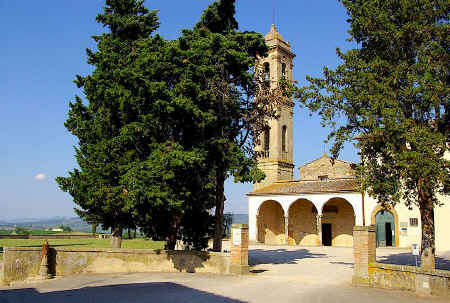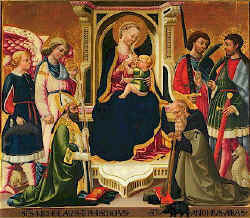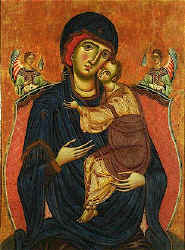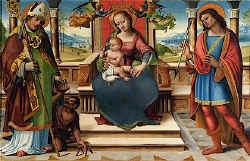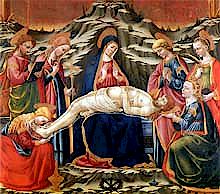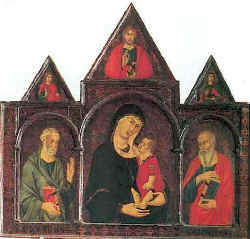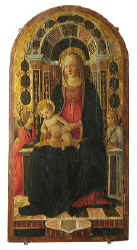|
The Museum of Religious Art at Tavarnelle in Val di Pesa was opened in 1989 on the first floor of the canons' house of San Pietro in Bossolo and contains works of art from the ancient Parish Church of San Pietro and the Church of San Donato in Poggio. Part of the important nucleus of work directly pertinent to the Parish Church of San Donato has been left on site, while the remainder is preserved in the Museum of Santo Stefano al Ponte in Florence. Parish Church of San Pietro in BossoloThe Parish Church of San Pietro in Bossolo was rebuilt in Romanesque style before the middle of the 11 C. However, the many architectural additions over the centuries has considerably changed its exterior, so that only a minor part of the original structure is still visible. The recent restoration returned the interior towards its original appearance. The rows of stone in the walls and the pilasters have been uncovered and the many additions that previously spoiled the church's severe linear geometry have been removed. The nave and two aisles are divided into five sectors of equal width, supported by simple square pilasters with low open plinths and simple cornices at the top instead of capitals. The only other ornamental motif is the inset moulding that runs around the entire extrados of each of the arches. The Pieve di San Pietro in Bossolo The parish church is thought to have been founded by the Degli Alamanni family, and was at first the property of the Florentine Bishops and later of the Cathedral Chapter, which exercised its authority over it until 1340. Its patronage passed to the noble Buondelmonti family during the 15 C. When Andrea Buondelmonti, a member of that family, was parish priest and canon of the church, he promoted a series of important restoration works and enlargements. In 1508, he financed the reconstruction of the canon's house and, two years later, had it enlarged on the southeastern side, when he also added the portico onto the front of the church. The interior of the church was further altered during the next two centuries, until it completely lost its original character. Fortunately the radical restructuring and restoration carried out in 1946 returned it to its original state. The bell tower and the opening of the small Baptistery Chapel beside it date date from the last century.
The Museum of TavarnelleThe canon's house, now in part the Museum of Religious Art, is reached from the cloisters. The museum catalogue groups the various works together according to their original provenance. A tour of the museum starts from the centre room on the first floor that hosts the paintings and furnishings from the Parish Church of San Pietro in Bossolo. At present, the original church property is composed of some valuable pieces of goldwork, among them a processional cross dating from around the 13 C, a few reliquaries in carved wood and some examples of liturgical vestments that were once part of the ancient furnishings. However, the Parish Church has also long hosted two extremely well-known paintings of great artistic value, the Madonna of Grace painted in the first half of the 15 C by Rossello di Jacopo Franchi and the 13 C painting on wood of the Madonna and Child, attributed to Meliore. The latter has become something of a symbol of this museum, partly because of the fact that such an early painting (ca. 1270-1280) has managed to survive to this day is always of exceptional importance, and partly because it is particularly famous and greatly studied, sometimes included in and sometimes removed from the artist's catalogue of work. The same room also contains a group of paintings on wood that are significant as far as the production of 15 C minor artists is concerned and which offer an occasion for focusing on the important aspects of a family-run workshop: they include a very fragmentary Madonna and Child, attributed to Lorenzo di Bicci and dating from around the late 14 C, and a series of six paintings carried out by his grandson Neri di Bicci in the 1570's that portray the Madonna and Child enthroned between St. Nicholas, the Angel Raphael and Tobias, St. Anthony Abbot, St. Domninus and St. Julian, the Lamentation over the dead Christ, with Sts. Luke, Margaret, Mary Magdalen and John the Evangelist, and some fragments, once part of an altarpiece, showing the Virgin Mary and St. Sebastian, St. John and St. Rochus, as well as two portraits of Friar Luca Lanfranchini from Mantua and Niccolò Sernigi, founders of the convent of Santa Maria at Morrocco, where the entire group of works comes from.
The di Bicci family
Lorenzo di Bicci, an exponent of the more traditional current in 15 C Florentine painting, was the founder of one of the largest and most active artistic workshops in the city. He was joined by his son
Bicci di Lorenzo (whose works can be found in a great many churches in the countryside), during the 15th century, and followed by his grandson
Neri di Bicci, who, after a period of apprenticeship, inherited both the workshop management and clients. The paintings on wood that Neri carried out for Santa Maria of Morrocco form a unique and extremely interesting group, because of their executive quality, their excellent state of conservation, and documentary certainty. The paintings of the Holy Conversation and the Lamentation are both mentioned in the painter's memoirs, where we can read that Niccolò Sernigi ordered them in 1472. The same patron also commissioned the altarpiece for the high altar, later dismantled, in
1475. According to the theory of Rosanna Proto Pisani, this work was composed of the Trinity with the scene of the crucified Christ in the centre, with the images in the fragments mentioned above on either side.
The silverware is grouped together in the centre of the room, according to the church of origin. The oldest silverware on display includes the two
13 C processional crosses, with engravings representing the traditional scene of the Mourners on either side of Christ and the four symbols of the Evangelists along the arms of the
cross. Both have a linear outline and are without the terminal plaquettes used in later crosses; a
15 C chalice, that still conserves the enamels on the jointure the stem; and two thuribles, one temple-shaped and the other vaguely pyramidal in form, dating from the same period, but still based on
14 C models. A great many 17 C and 18 C furnishings of Florentine and Tuscan manufacture are also on display here. One of the most valuable examples is a chalice from San Bartolomeo at Palazzuolo, and a collection of Neapolitan silverware, all dating from the
19 C, except for the beautiful monstrance carried out by Nicola De Angelis in 1706. Two canvases in particular are worthy of note from among the 18 C paintings from the Church of Cortine, as they make up a "pendant": the St. Joseph with the Baby Jesus, by a follower of Sagrestani, and the Sts. Peter and Paul by Francesco Conti. The remainder of the exhibits in the room include another group of 17th and 18th century silverware, beautifully made, but stylistically fairly ordinary, and an unusual 19 C cupboard in painted and carved wood, whose lower part was used as an altar table, while the upper part is divided into compartments to contain reliquaries.
Votive objects, fabrics and vestmentsThe third room is dedicated to devotional objects and contains, apart from a large group of reliquaries in wood and silver (in the form of aediculas or urns, like
monstrances), canvases portraying religious subjects: an
18 C St. Lawrence that comes from San Lorenzo at Cortine; and the St. Peter from
Olena, dated 1770 and signed by Stefano Amigoli, a follower of Francesco Conti and active in Florence in the second half of the
18 C. The two other small paintings on wood present in the room portraying St. Luke (n. 15a) and St. Mark (n. 15b), were carried out by an unknown painter of Tuscan school and formed part of a
17 C group of four Evangelists, where each saint is shown seated, with an open book and his personal iconographic symbol beside him. Museum of Farm LifeMuseo E. Ferrari di Cultura ContadinaIn the
Castello di San Donato in Poggio located in via del Giglio there is a museum named after Emilio Ferrari, an engineer who made available for public viewing an extensive collection of tools, utensils and equipment. These items provide a revealing insight into the way in which the productive activities and small-scale rural craft industries of the Chianti region functioned. There are also numerous copper utensils and containers of various origins, mainly from the
19 C. |
